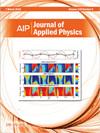Characterization of radical-enhanced atomic layer deposition process based on microwave surface wave generated plasma
IF 2.7
3区 物理与天体物理
Q2 PHYSICS, APPLIED
引用次数: 4
Abstract
A plasma-assisted atomic layer deposition system employing a microwave surfatron plasma was developed and characterized by spatially resolved Langmuir probe diagnostics and optical emission spectroscopy. The deposition process was applied on TiO2 thin films prepared on Si wafers. The surfatron is equipped with a small ring electrode serving as a source of weak radio frequency plasma helping with fast and reliable ignition of the discharge in molecular gas. Results evaluated in the pure argon plasma proved that the plasma potential and the plasma density are homogeneous in the radial direction, while a rapid decrease was observed in the axial direction. Adding up to 30% of nitrogen into the gas mixture led to less homogeneous plasma parameters in the radial direction together with the increase of the electron effective temperature. Optical emission spectra revealed many Ar I lines of neutral atoms with only a few Ar II ions’ lines. The gradual addition of nitrogen causes a systematic decrease in the Ar I line intensity. We expect that excited nitrogen molecules are produced by the inelastic collisions with electrons and by the collisional quenching of metastable Ar(4s) states. On the other hand, oxygen atom and ion lines are detected when oxygen was mixed with argon. Deposited TiO2 thin films are characterized by the anatase phase when the substrate temperature is 250 °C. The anatase phase is observed even for the substrate temperature of 200 °C; however, the microwave power delivered into the surfatrons must be lower in comparison with the prior case.基于微波表面波等离子体的自由基增强原子层沉积过程表征
研制了一种利用微波表面电子等离子体的等离子体辅助原子层沉积系统,并利用空间分辨朗缪尔探针诊断和光学发射光谱对其进行了表征。将该沉积工艺应用于硅片上制备的TiO2薄膜。表面加速器配备了一个小环形电极,作为弱射频等离子体的来源,有助于快速可靠地点燃分子气体中的放电。在纯氩等离子体中进行的实验结果表明,等离子体势和密度在径向上是均匀的,而在轴向上急剧下降。当氮气含量达到30%时,等离子体径向参数不均匀,电子有效温度升高。光学发射光谱显示中性原子有许多Ar I谱线,只有少数Ar II离子谱线。氮的逐渐加入导致了ari线强度的系统性降低。我们认为受激氮分子是由与电子的非弹性碰撞和亚稳Ar(4s)态的碰撞猝灭产生的。另一方面,当氧与氩混合时,可以检测到氧原子和离子线。当衬底温度为250℃时,沉积的TiO2薄膜以锐钛矿相为特征。当衬底温度为200℃时,仍可观察到锐钛矿相;然而,与先前的情况相比,传递到表面电子的微波功率必须更低。
本文章由计算机程序翻译,如有差异,请以英文原文为准。
求助全文
约1分钟内获得全文
求助全文
来源期刊

Journal of Applied Physics
物理-物理:应用
CiteScore
5.40
自引率
9.40%
发文量
1534
审稿时长
2.3 months
期刊介绍:
The Journal of Applied Physics (JAP) is an influential international journal publishing significant new experimental and theoretical results of applied physics research.
Topics covered in JAP are diverse and reflect the most current applied physics research, including:
Dielectrics, ferroelectrics, and multiferroics-
Electrical discharges, plasmas, and plasma-surface interactions-
Emerging, interdisciplinary, and other fields of applied physics-
Magnetism, spintronics, and superconductivity-
Organic-Inorganic systems, including organic electronics-
Photonics, plasmonics, photovoltaics, lasers, optical materials, and phenomena-
Physics of devices and sensors-
Physics of materials, including electrical, thermal, mechanical and other properties-
Physics of matter under extreme conditions-
Physics of nanoscale and low-dimensional systems, including atomic and quantum phenomena-
Physics of semiconductors-
Soft matter, fluids, and biophysics-
Thin films, interfaces, and surfaces
 求助内容:
求助内容: 应助结果提醒方式:
应助结果提醒方式:


